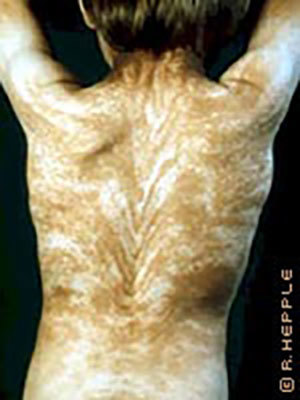
On a CSI episode, why did the chimera have swirl patterns on his skin?
November 30, 2004

- Related Topics:
- Chimera,
- Rare events,
- Quirky questions,
- Skin pigmentation
Curious adults from Kansas and Australia ask:
“1) On the CSI episode about the chimera, there was a disease mentioned (or shown) that began with a B. Do you know what that is? And why were there swirled patterns on the suspect's back when the special glasses were put on?
2) In the chimera episode, the fact that the guy was a chimera was first established through a camera flash on the skin illuminating skin anomalies (potentially through radiation??). Why is this the case? Presumably the bone marrow donor would not have been subject to radiation?”
In the episode, what the investigator discovered was something called Blaschko’s lines. These swirling patterns are found on the backs of many chimeras. Often you need UV light to see them.
These patterns arise from the fact that chimeras start out with two cells, each with different DNA. Remember, DNA is a set of instructions for creating and running an individual. Because a chimera starts out with two cells with different DNA, the chimera ends up with some cells that have one set of instructions and others that have a different set.
The skin of a chimera is made up of two sets of cells, each with different DNA. One of the instructions DNA has is how dark to make the skin. The Blaschko’s lines result from the fact that some of a chimera's skin cells say “make darker skin” and some say “make lighter skin.”

When there is a big difference between the two DNA’s instructions on how dark to make the skin, then you get obvious Blaschko’s lines. If the differences are more subtle, then you might need something extra like UV light to see the pattern.
A German dermatologist named Alfred Blaschko first noted these lines more than a century ago. He noticed that in some skin diseases, the pattern was linear on the arms and legs, S-shaped on the stomach and V shaped on the back. The patterns are just a consequence of how the skin develops. If it developed differently, you would end up with a different pattern.
So there you have it. These Blaschko’s lines are there for the rest of us but invisible because all of our cells have the same instructions for how dark to make our skin. They only become apparent with certain skin conditions or if the two populations of cells have different DNA.

Author: Dr. Barry Starr
Barry served as The Tech Geneticist from 2002-2018. He founded Ask-a-Geneticist, answered thousands of questions submitted by people from all around the world, and oversaw and edited all articles published during his tenure. AAG is part of the Stanford at The Tech program, which brings Stanford scientists to The Tech to answer questions for this site, as well as to run science activities with visitors at The Tech Interactive in downtown San Jose.
 Skip Navigation
Skip Navigation
